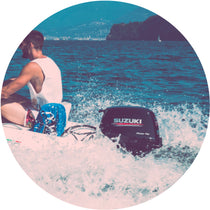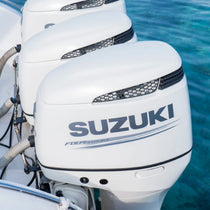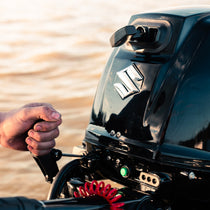For boat owners with a Suzuki outboard, fuel system issues can put a damper on a fun boating season. From poor performance to reduced gas mileage, having your outboard running suboptimally – or not at all – can be distressing, especially when you want to relax on the water.
Suzuki recommends that you inspect your Suzuki outboard fuel system on a seasonal or regular basis. Luckily, performing maintenance on your Suzuki outboard fuel system is relatively simple for most amateur boaters and can save you plenty of money. You should take the time necessary to maintain and inspect your boat’s entire fuel system to ensure that all components are working properly and safely.
In this article, we will cover what you need to maintain for your Suzuki outboard fuel system, including:
- Fuel tank
- In-line fuel filter
- Water separator
- Fuel treatments
- And fuel lines
Fuel Tank
To start any work on your Suzuki outboard fuel system, you’ll want to clamp off any hoses connecting your fuel tank to the outboard. If the fuel lines aren’t properly clamped, fuel will siphon off and drain as you service the engine.
Your Suzuki Outboard’s fuel tank is crucial to keep your outboard running in top condition. Regular outboard maintenance requires you to periodically drain the fuel tank to remove any trapped particles and contaminants that may have entered your fuel system.

While these particles may not immediately enter your fuel system, when fuel gets low, or the particles float in suspension, these particles will eventually reach your engine and potentially cause damage. As you repair and replace fuel filters (see below), you will notice debris trapped in the filter(s) that has entered the outboard’s fuel system, degrading the filters and requiring more frequent replacements.
Also, keep your fuel tank as full as possible to avoid condensation from the air entering your fuel system. Keeping your fuel tank full is important when you’re regularly using your Suzuki outboard or before winterization, but most marine engine manufacturers and technicians advise leaving just a little capacity to accommodate fuel expansion if the temperature warms.
In-line Fuel Filter
Your Suzuki outboard is equipped with an in-line fuel filter that traps any particles that enter your engine. Suzuki recommends replacing this fuel filter every 100 hours or annually (whichever comes first). Over time, the filtering element inside the housing can break down. It’s important to inspect this filter for any signs of degradation regularly and replace it when needed. Also, it’s a good idea always to carry spare fuel filters, as one tankful of bad gas can quickly plug a new filter and cause significant performance issues.
Here’s how to replace your in-line fuel filter on most models of Suzuki outboards:
- Begin by removing the fuel filter from its rubber bracket.
- Disconnect the two fuel hoses from the filter and their pipe clamps. Pay attention to the orientation of the in-line fuel filter, as you’ll need to install the hoses in the correct order.
- There will be a reusable mounting bracket on top of the fuel filter. Carefully disconnect that from the fuel filter and set it aside to install the new fuel filter.
- Install the reusable mounting bracket on the top of the new fuel filter.
- Install the fuel hoses onto the new filter.
- Line up the tab on the back of the filter to lock it in place in the rubber bracket.
Pro tip: Mark the installation date of your new fuel filter with a permanent marker as a reminder of when you made the replacement.
Fuel-Water Separating Filter
Your Suzuki outboard fuel system is also equipped with a water separator filter. As the name implies, the water separator filter is responsible for separating any moisture that has entered your fuel system and capturing any debris in your fuel system. Beneath the filter element is a reusable fuel filter bowl, which is transparent for checking fuel condition and draining contaminants with a drain plug.

Here’s how to replace your fuel-water separating filter:
- Begin by placing a catch pan beneath the area of your water separator filter. When the filter is removed, some gasoline retained by the filter will spill out.
- Using a strap wrench for the filter, gradually turn the filter element clockwise to loosen it from its threading.
- Once you have removed the filter element, gently separate the bottom piece of the water separator (the fuel filter bowl) by turning counterclockwise. Using two wrenches may be necessary to separate these elements.
- Clean out the fuel filter bowl with a rag to remove any debris.
- Remove the old o-ring from the bottom of the threads of the water separator. Replace it with a new one (included in most Suzuki marine parts replacement filters). Oil up the o-ring with your finger to lightly oil the seal and create a better vacuum.
- Attach the water separator to a new filter element. Be sure to avoid overtightening.
- Replace the o-ring between the filter element and the engine. Oil up the o-ring with your finger to lightly oil the seal and create a better vacuum.
- Line up the threads of the filter element and turn counterclockwise by hand until firm.
- Using a strap wrench, continue tightening ¾ of a turn to complete the seal.
Pro tip #1: Mark the installation date of your new fuel filter element with a permanent marker. This will remind you of when you made the replacement.
Pro tip #2: Look at any spilled gasoline in your catch pan. You may notice sediment and water, possibly indicating a leak, a bad batch of gas, or other problems.
Fuel Treatment
One of the most overlooked parts of Suzuki Outboard Fuel System maintenance is the fuel itself.
Boating experts recommend using the lowest ethanol-content fuel possible because ethanol attracts water into your fuel system through the process of “phase separation.” This means that moisture is more likely to enter the fuel system, inviting internal corrosion and uneven performance on the water. Typically, phase separation occurs within 90 days of filling up. So, it’s important to treat your fuel with a quality fuel additive like Suzuki’s Ecstar Fuel Conditioner & Water Remover as soon as possible.
To avoid phase separation, add fuel stabilizer every time you fill your gas tank or winterize your Suzuki outboard.

Fuel Lines
Your Suzuki outboard fuel lines obviously are an essential part of your fuel system. Be sure to visually inspect them whenever possible. Look for signs of damage, such as cracks and wear, and evidence of leakage.
Over time, your fuel lines will degrade and need replacement. Most experts recommend replacing fuel lines every 3 – 5 years, so be sure to perform this maintenance if you’ve owned the outboard for some time.
In conclusion, performing maintenance on your Suzuki outboard fuel system is relatively straightforward and should be part of your regularly scheduled maintenance. To make things even easier, PartsVu has plenty of Suzuki marine parts to help you boat safely and more reliably. Better yet, check out PartsVu’s handy Suzuki outboard maintenance kits to make repairing your outboard a cinch! Happy boating!



















